
Manchego is a cheese made in the La Mancha region of Spain from the milk of sheep of the Manchega breed. It is aged between 60 days and 2 years.
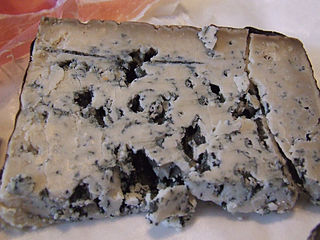
Cabrales is a blue cheese made in the artisan tradition by rural dairy farmers in Asturias, Spain. This cheese can be made from pure, unpasteurized cow’s milk or blended in the traditional manner with goat and/or sheep milk, which lends the cheese a stronger, spicier flavor.
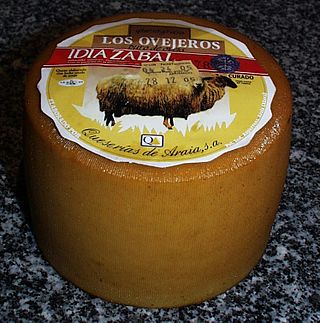
Idiazabal is a pressed cheese made from unpasteurized sheep milk, usually from Latxa and Carranzana sheep in the Basque Country and Navarre. It has a somewhat smokey flavor, but is usually un-smoked.

Goat cheese, goat's cheese, or chèvre is cheese made from goat's milk. Goats were among the first animals to be domesticated for producing food. Goat cheese is made around the world with a variety of recipes, giving many different styles of cheeses, from fresh and soft to aged and hard.

Afuega'l pitu is an unpasteurised cow's milk cheese from Asturias, one of four Asturian cheeses to have been recognized with Protected Designation of Origin by Spain and the European Union.

Asturian Mountain is a local Spanish breed of cattle named after the Asturias, which possess breeding capacity and docility. They are primarily raised in the east of Asturias, in the north of Spain, particularly in the mountain range of the Picos de Europa, including within the National Park of Covadonga. The breed is also known as the Casina They are beef cattle and one of three breeds used to produce Casín cheese.

Picón Bejes-Tresviso is a blue cheese from Cantabria, in the north of Spain. It has been protected under Denominación de Origen (DO) legislation since 1994, prior to which it was traditionally known as Picón de Tresviso and Queso Picón de Bejes. The designated area centers in the Liébana valley and production is restricted to the municipalities of Potes, Pesaguero, Cabezón de Liébana, Camaleño, Cillorigo de Liébana, Peñarrubia, Tresviso and Vega de Liébana.

Asturian Valley cattle originate from the valleys of Asturias, Spain. They are mostly raised in the northern coastal areas on the Bay of Biscay and the river valleys at the foot of the Cordillera Cantábrica mountain range. This breed belongs to an exclusive bovine group in Spain known as the tronco Cantábrico that only includes breeds native to northern Spain; it also includes the Asturian Valley cattle. of all those breeds, Asturian Valley maintain the largest number. Traditionally the cattle were used for milk, meat, and work. Since other milk breeds have been introduced to Spain, their prominence has declined in the dairy industry. They remain one of three breeds that may be used to produce Casín cheese.
Alpujarras cheese is a Spanish cheese from the eastern region of Andalusia, which includes the provinces of Granada, Almería and the Penibética mountain chain. The cheese takes its name from La Alpujarra, a mountainous region which occupies a part of southern Granada province and western Almeria province. This area has a long history and tradition of goatherding. Alpujarras cheese is made from the milk of the White Andalusian domesticated goat.

Gamonéu cheese is a fatty Spanish cheese made in certain parts of the Principality of Asturias. Taking its name from the village of Gamonéu where it was originally made, Gamonéu cheese has a Protected Designation of Origin. It is a lightly smoked cheese with a thin, natural rind that is coloured brownish with some red, green and blue patches. Moulds on the rind slightly invade the interior of the cheese. Similar to other cheeses in the region, Gamonéu is made from a combination of cow, goat and sheep milks. Gamonéu cheese is sold in the form of a truckle cylinders with flat ends in weights varying between 500g to 7 kg (15 lbs). Gamonéu comes in two distinct forms: "del Puertu", which is made in the high passes and "del Valle", which is made in the lower valleys. Gamonéu del Puertu is harder and drier and is the rarer of the two forms as production is limited to the summer months in the uplands. Gamonéu del Valle is richer and creamer and production continues year-round.

Flor de Guía cheese is a Spanish cheese made on the island of Gran Canaria in the Canary Islands. It has Denomination of Origin protection. The cheese is classified as fatty or semi-fatty and made from the milk from Canarian sheep, with milk from Canarian cows and/or goats. The milk from the sheep must constitute at least 60% and cows’ milk content must never exceed 40%. Goat milk must never exceed 10% of the mixture. The cheese is presented in flat cylindrical cheeses which normally measure 4–8 cm high and 20–30 cm across and weighing between 2 and 5 kg. The cheese gets its name from an area in northern Gran Canaria called Santa María de Guía, where the cheese is made, and ‘flor’ from the fact that juice from the flowerheads of a species of cardoon and globe artichoke are used to curdle the milk.

Palmero cheese is a Spanish plain or lightly smoked cheese from the island of La Palma in the Canary Islands. It is made of unpasteurised goats milk and has Denomination of Origin protection. The goats are free to graze on natural wild plants which are available all year round. The cheese is made on many small farms all over the island. It is presented in cylindrical cheeses of up to 15 kilos (33 lbs).
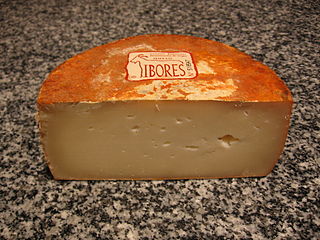
The Ibores cheese is a Spanish cheese made from unpasteurized goats’ milk in Extremadura. It has a Denomination of Origin protection in the European Union and is made specifically in the districts of Ibores, Villuercas, La Jara y Trujillo in the south east of the Province of Cáceres. It is a fatty cheese made exclusively from the milk of Serrana, Verata, Retinta breeds and crosses between them and only from farms registered with the regulatory council. The cheeses are flat cylindrical and measure 5–9 cm (2-3.5 inches) high and 11–15 cm (4-6 inches) across. They weigh from 600 to 1200 g (1-2 lbs).
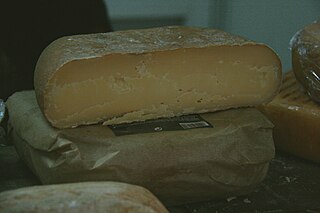
Mallorca cheese is a Spanish cheese made exclusively on the island of Mallorca, one of the Balearic Islands in the Mediterranean Sea. It has Protected Designation of Origin and is made from the pasteurized milk of cows, goats and/or sheep which live on the island. The cheeses are slightly tapering, flat cylinders which measure 12–20 cm (5-8 inches) across and 7-9 cm (3-4 inches) high. They weigh from 750 g to 4 kg (1.5-9 lbs). Mallorca cheese is produced in three types:
Murcian cheese is a fatty goats' milk cheese from the Murcia region of south-east Spain. It has a Protected Designation of Origin. The cheese is made exclusively using goat's milk of the Murcian breed from registered herds which graze freely on scrub and coarse pasture characteristic of that dry geographical zone. The cheese is made in two forms:
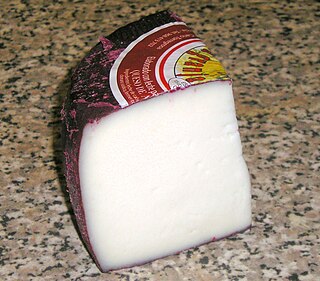
Murcian wine cheese is a fatty goats’ milk cheese from the province of Murcia in the south-east of Spain. It has a Protected Designation of Origin. The cheese is made only from unpasteurized goats’ milk of the Murcian breed from registered herds. The term al vino refers to the washing of the rind with red wine during maturation. The cheese is presented in cylinders 6–7 cm (2-3 inches) high and 7–9 cm (3-4 inches) diameter weighing 400 g, or 7–9 cm (3-4 inches) high and 12–18 cm (5-7 inches) diameter weighing 1 kg (2.2 lbs) or 2 kg (4.4 lbs).
Cantabrian cream cheese is made from the milk of Friesian cows in Cantabria, an autonomous community in northern Spain. The cheese has a Protected Designation of Origin since 1985. The production of the cheese is confined to all parts of Cantabria, except the areas of Tresviso and Menor de Bejes in the western part of the region. It is presented in forms of various weights from 400 – 2,800 g. The size of the forms varies according to the weight.

Quartirolo Lombardo is a soft table cheese made with cow's milk, which has a Protected designation of origin (PDO) status.
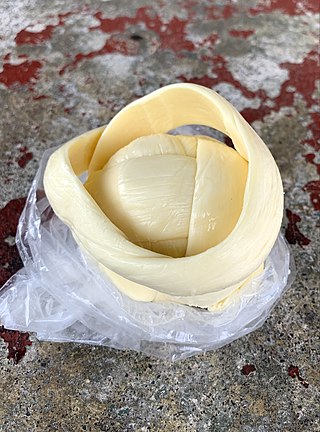
Palmito cheese is a popular fresh cheese from Costa Rica that resembles a knotted ball of string cheese. It has been described as light, salty, and stringy with a texture comparable to mozzarella cheese. It is similar to Oaxaca cheese in Mexico and quesillo in Nicaragua. It is a type of stretched-curd cheese made by using the pasta filata technique. It is thought that the technology to produce the cheese came from Italian immigrants. At an expo in Zarcero in 2007, a 132 kg ball of palmito cheese was created by local cheesemakers.
















